Beginning gardeners often do not know what herbicides are, but over time, the need to learn more about them will definitely arise. Weeds appear instantly, after the snow melts and the first warming of the earth by the sun's rays, they stick out the tops of the soil, while taking away the nutritional properties of cultivated plants.
After a while, weeds obscure them with their shadow, preventing the planted crops from developing. To avoid this, frequent and systematic herbicide treatment of weeds is carried out, which gives a reliable result for the whole season.
Herbicides are chemicals that have a detrimental effect on the life processes of plants. They are used exclusively for weeds. These funds differ in the specifics of the application, so you need to know which drug is best to use. This article discusses the most common types of herbicides.
"Agrokiller" is a herbicide of continuous action, designed to combat malicious weeds. The drug easily destroys plants that are difficult to exterminate, such as cow parsnip, thistle, wheatgrass, as well as unnecessary growth of trees and shrubs, due to the high concentration of active ingredients. With the help of "Agrokiller" weed control is fast.
Did you know? You can even clean areas that have not been touched for a long time.
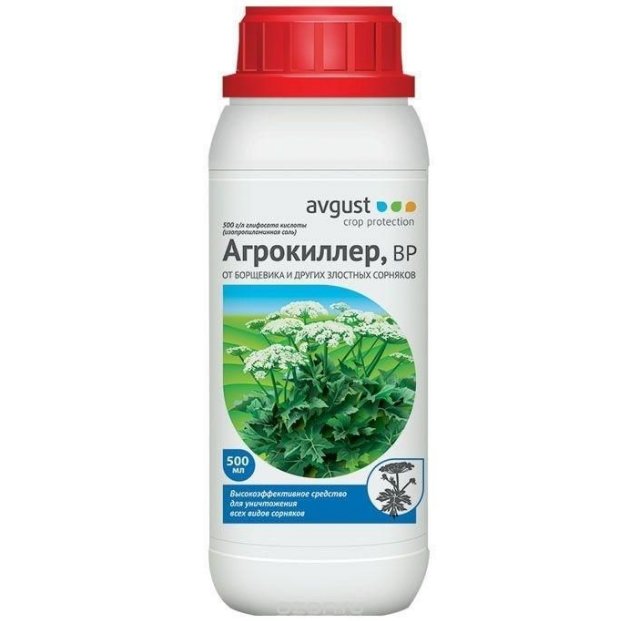 It is best to use the drug with the arrival of a warm spring or early summer. At this time, the plants have active sap flow, which contributes to the accelerated spread of the herbicide through their tissues.
It is best to use the drug with the arrival of a warm spring or early summer. At this time, the plants have active sap flow, which contributes to the accelerated spread of the herbicide through their tissues.
Before sowing lawn grass, Agrokiller is ideal, since it does not have soil activity.
Important! After 6 hours from the moment of applying the drug to the shoots or leaves, the plant completely absorbs it. On the 6-7th day, "Agrokiller" penetrates into other parts of the plant, including the root system. The process of amino acid synthesis is destroyed, and the plant dies. Herbicide treatment works at any temperature.
"Antiburyan"
Herbicide "Antiburyan"- This is a systemic drug of continuous action, which is used to exterminate perennial and annual weeds. It is better to apply it on soils before planting crops or after harvesting. Also, the drug is perfect for non-agricultural land. "Antiburyan" destroys more than 300 varieties of weeds and has high efficiency.
Did you know? The advantage of the drug is that it does not accumulate in the soil. The herbicide "Antiburian" is one of the most popular herbicides, and the instructions for use are simple: weeds should be treated during the period of active growth, when the plant reaches a height of up to 15 cm. Temperature conditions should be favorable, the allowable range is from +12 ° C to +25 ° C. It is also very important that there is no rain for 5 hours after spraying with the drug.
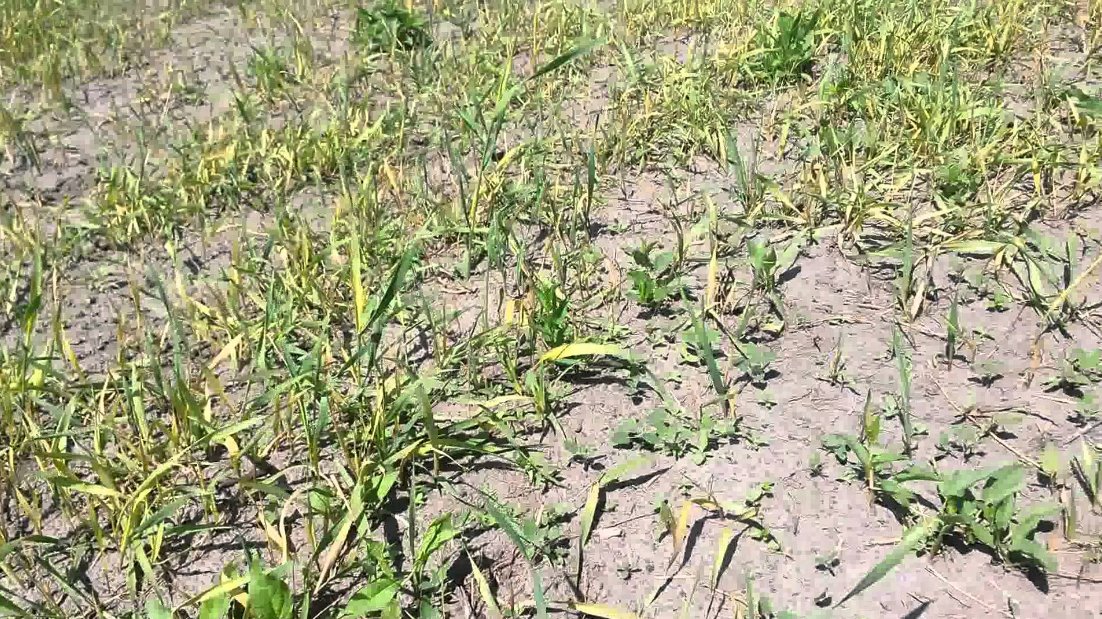
"Antipyrey"
Herbicide "Antipyrey"- This is a post-emergence systemic preparation that is used to eliminate perennial and annual weeds. Especially good results shows on the planting of vegetable crops. The leaf surface of the grassy weed species absorbs the agent, which soon spreads to all parts, including the roots.
The active substance of the herbicide is concentrated at the points of growth, as a result, lipid biosynthesis is blocked, and the plant dies - both its aerial part and the root system, and the re-growth of weeds is no longer possible.
Important! The chemical weed killer "Antipyrey" will not be washed off by rain within 30 minutes after spraying.
is a continuous herbicide effective against the destruction of annual and perennial grasses, trees and shrubs in non-agricultural areas.
Weather conditions do not affect the effectiveness of the drug. After spraying, the leaves and roots absorb the herbicide within one hour.
This poison from weeds of continuous action can be absorbed not only through the roots and leaves, but also through the soil. As a result, the processing period increases from early spring to late autumn. Arsenal is applied once every 2-3 years, since high results kept for more than one year. 
Important! hallmark of this herbicide is that it can destroy plants even if they are covered oil substances or a layer of dust. The herbicide "Arsenal" has the following instructions for use: the spray tank must be filled with water by ⅓ and slowly, stirring, add the drug until the container is full. The prepared solution is used immediately after its preparation. The treatment of the area should be carried out with the agitator turned on inside the tank; after finishing work, it must be thoroughly rinsed with water.
"Deimos"
The drug "Deimos" is a systemic herbicide that destroys annual and almost all perennial dicotyledonous weeds in areas with grain crops. Penetrating into the leaves and root system, the herbicide leads to the death of the plant. "Deimos" has good compatibility with other herbicides in tank mixes. The advantage of this type of herbicide is its high efficiency against weeds that are resistant to drugs from other chemical classes.
Weed killer "Zenkor" is a systemic herbicide that effectively fights broadleaf and grass weeds. in areas where tomatoes, potatoes, soybeans and alfalfa are grown. The drug penetrates through the leaves and soil, can destroy weeds that are just germinating, as well as those that have already sprouted. Early treatment of the site contributes to the fact that only cultivated plants receive nutrients, sunlight, and water. 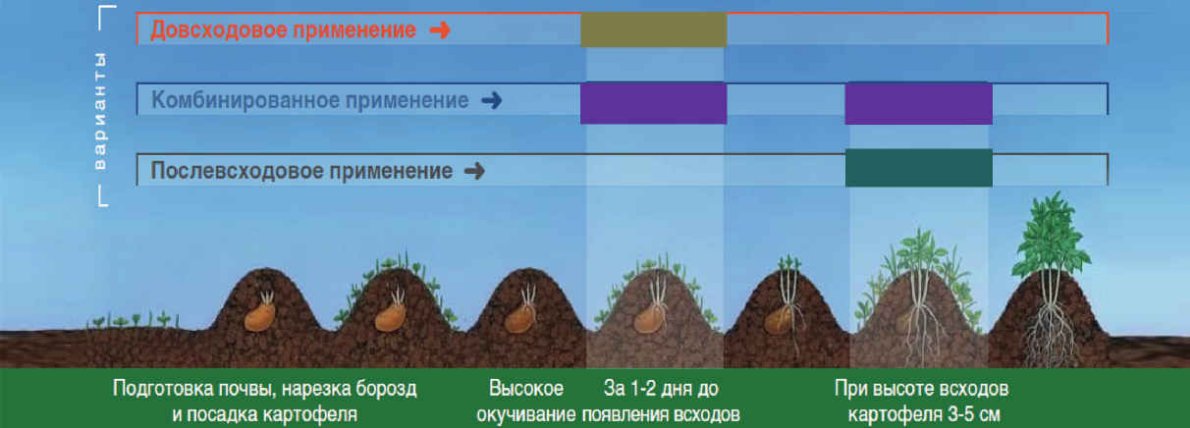
Important! The amount of the drug that is needed to kill weeds depends on the type of soil. For example, for a light one, only 5.0 g per one hundred square meters is enough, for a medium one - up to 10 g, and for a heavy one - up to 15 g. For potatoes, processing is best done when it has just risen, and weeds are already on the surface of the soil.
"Lapis lazuli"
Selective herbicides are also used quite often to get rid of weeds. "Lapis lazuli"- This is a drug designed to control weeds. in areas where potatoes are planted. A distinctive feature of "Lazurit" is that it destroys weeds selectively, without adversely affecting potatoes.
You can process the site immediately after planting potato tubers, 10 g of solution per 3 liters of water is enough for 1 weave. This herbicide is absorbed mainly by the root system, which allows you to destroy both vegetative weeds and seedlings in the soil, as well as prevent the emergence of new ones.
Did you know? If the tops of potatoes have grown to 5 cm, and weeds have flooded the entire area, it is possible to carry out herbicide treatment.
The weed killer protects the crop for 1-2 months. 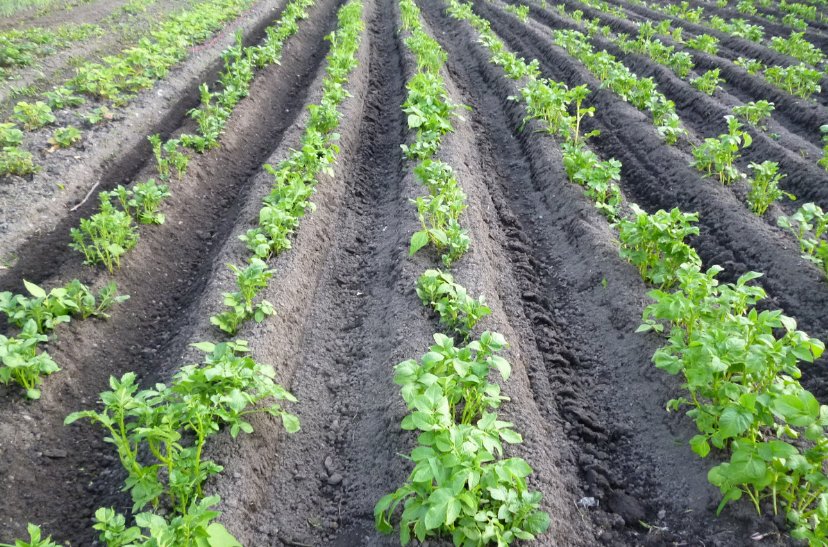
"Lontrel"
Herbicide "Lontrel" is a systemic drug of selective action, designed to combat annual and perennial weeds in areas of strawberries and strawberries. The remedy is effective against weeds, which are very difficult to eradicate, for example: plantain, dandelion, sorrel, chamomile, cornflowers and others. After spraying, penetrating the leaves, the herbicide quickly spreads to the place of growth and destroys both the aerial parts and the root system, and after a few hours their growth stops.
Within 2.5-4 weeks after treatment, the weeds die completely. Of the features of the herbicide "Lontrel" it can be noted that the product is highly effective and does not have a negative impact on the planted strawberries and strawberries, and also does not accumulate in the ground.
is a selective herbicide for the control of annual and perennial cereal post-emergence weeds.
Important! This drug does not work on dicotyledonous weeds.
After treatment, the herbicide quickly begins to be absorbed by the leaves. After that, the agent spreads to the stem, roots, and subsequently the plant dies. The first results of spraying can be seen after 7 days, and complete death occurs within 2-3 weeks. 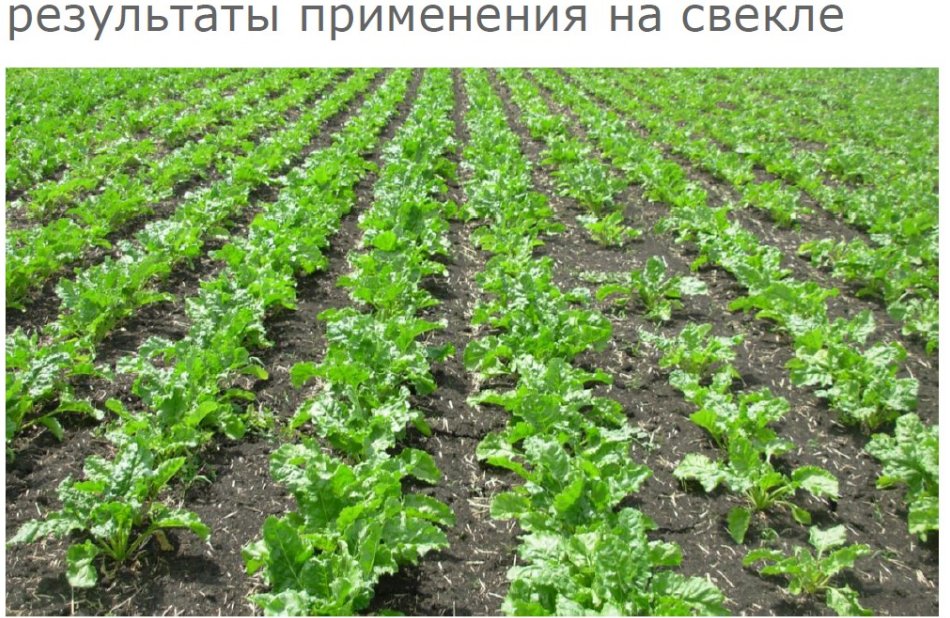
Such weed preparations are not absorbed into the soil, which means that they will only act on those weeds that were at the time of treatment. If you need to kill dicotyledonous weeds on the site, then Miura can be mixed with a herbicide against dicotyledonous weeds. The tool is effective both in the early stages of plant development and in the later ones, but during the period of active growth, the best results can be achieved.
Herbicide "Roundup"- is a universal drug of continuous action, designed to combat perennial, annual, grass and dicotyledonous weeds. This is a very effective tool, widely used in agriculture.
After applying the herbicide to the plant, after 6 hours, the leaves and shoots completely absorb the drug, and after 6-7 days it penetrates the root system and other parts of the weeds. As a result, the synthesis of amino acids of the weed is disturbed, and it dies. "Roundup", like "Tornado", does not affect the soil, when it hits, it loses all its activity, so the drug does not affect the germination of seeds of planted crops.
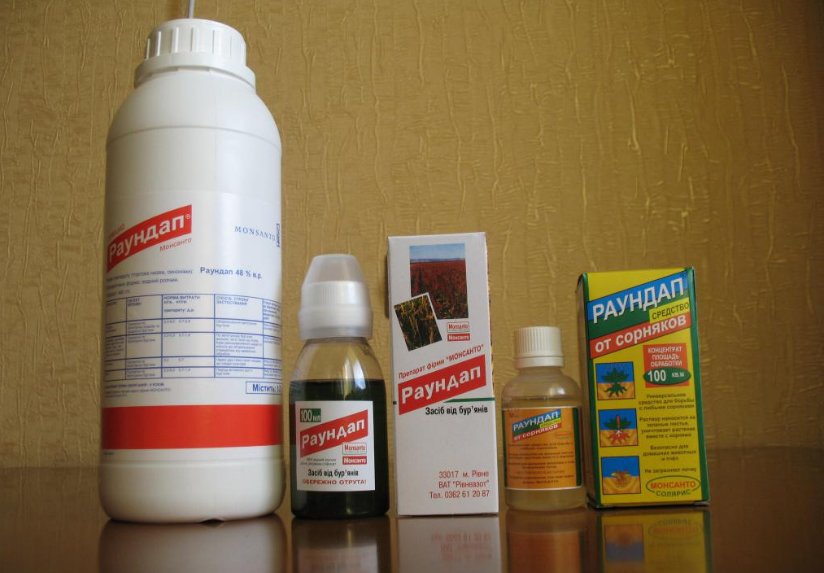
"Tornado"
"Tornado" is a systemic herbicide of continuous action for the removal of annual and perennial weeds. This drug is one of the most common herbicides and is used on agricultural plots, as well as in vineyards. When processed, it first penetrates the stems and leaves, then spreads to the root system, stops the synthesis of amino acids and completely destroys the plant.
Effective against such weeds as cattail, creeping wheatgrass, bindweed, thistle, pig and reed. Of the advantages, it can be noted that there is no soil activity, and immediately after processing, any crop can be sown. The spraying procedure can be carried out at any temperature, the main thing is that the plant retains its viability.
"Tornado BAU"
Herbicide "Tornado BAU" is a drug of continuous action that fights all types of weeds: annuals, perennials, cereal dicotyledonous and monocotyledonous. Herbicides for the treatment of the site require the correct dosage, which depends on the type of weeds and their development. 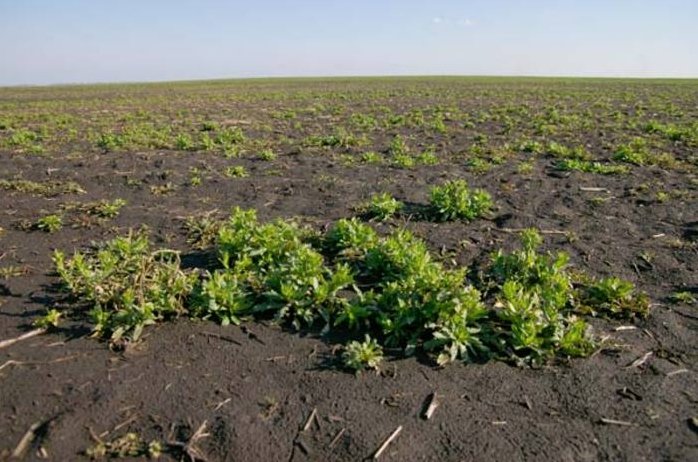 After spraying, the shoots and leaves absorb the drug in 6 hours, then it spreads to the root system and other parts of the weed in 6-7 days, and as a result of a violation of the synthesis of amino acids, the plant dies. Works exclusively on green leaves, is inactive on the soil, decomposes into natural substances.
After spraying, the shoots and leaves absorb the drug in 6 hours, then it spreads to the root system and other parts of the weed in 6-7 days, and as a result of a violation of the synthesis of amino acids, the plant dies. Works exclusively on green leaves, is inactive on the soil, decomposes into natural substances.
"Hurricane"
Herbicide "Hurricane"- This is a non-selective systemic preparation that destroys perennial and annual weeds. Used in agricultural areas intended for planting potatoes, vegetables, vineyards. When hit on weeds, "Hurricane" is quickly absorbed through the leaves, spreads to the roots, and after 9-14 days the weeds completely die. Efficiency increases in dry and cold weather. Weeds treated with this herbicide do not grow back.
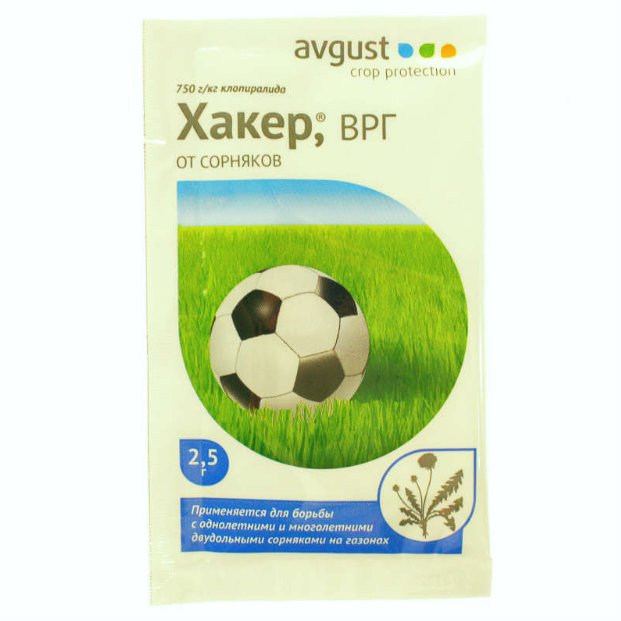 is a systemic post-emergence herbicide of selective action, used to destroy some types of annual and perennial dicotyledonous weeds in areas where beets, cabbage, flax and rapeseed are sown.
is a systemic post-emergence herbicide of selective action, used to destroy some types of annual and perennial dicotyledonous weeds in areas where beets, cabbage, flax and rapeseed are sown.
The agent is absorbed by the leaves, spreading to the root system. All this happens within 2-3 hours after treatment. After 13-18 hours, you can notice the first signs of the drug's action: deformation and twisting of leaves and stems.
The period of protective action lasts until the end of the growing season. Processing is best carried out at a temperature of +10 °C to +25 °C. If, according to forecasts, there should be frosts, then it is not worth carrying out the procedure.
"Chistopol"
Universal herbicide "Chistopol" is a continuous action preparation used to control annual and perennial weeds in areas where cultivated plants will be sown. It is best to process during the growing season of weeds at temperatures from +12 ° C to +30 ° C. Since the root system dies later after spraying, it is necessary to work on the soil no earlier than after 14 days. Herbicide "Chistopol" is effective in the treatment of shrubs and woody vegetation.
Now when you encounter weeds, you will be ready to fight back. The use of herbicides in the country will allow you to grow on the site only those plants that you want. 
Was this article helpful?
Not really
Foreword
Necessary tools and materials
Every gardener and gardener is faced with the problem of weeds on the site. They tend to thrive in almost any conditions, the fight against them is carried out throughout the entire period of horticultural work. In this article, we will try to identify the best weed preparations.
1 Pest plants - get to know each other better
Among the most popular weeds, thistle is distinguished. It has a rather powerful root system and a prickly stem. Therefore, it is very difficult to pull it out of the ground with your hands; weeding helps poorly in the fight against it. If you pull out the sow thistle, and at least a small part of the root remains in the ground, all efforts are in vain, because it will grow again very quickly.


Weed removers are an effective, but not the only, method of control. Mulching is one of the non-chemical and yet very useful ways. It lies in the fact that the soil is covered with sawdust, tree bark or agroperlite (). Pests will simply wither and suffocate under the mulch. An additional effect of this method is the preservation of moisture in the soil.

An analogue of mulching is the "cardboard" method. Its essence is simple: take carton boxes, tear them apart. We cover the soil with them. Without sunlight, unnecessary plants die, and the cardboard that decomposes over time will also serve as fertilizer. Also, for the purpose of control, you can plant on the site those plants that are able to suppress pests. These include clover and lawn grass. Displaces weeds from the garden pumpkin and peas.

And some secrets...
Have you ever experienced unbearable joint pain? And you know firsthand what it is:
- inability to move easily and comfortably;
- discomfort when going up and down stairs;
- unpleasant crunch, clicking not of their own free will;
- pain during or after exercise;
- inflammation in the joints and swelling;
- causeless and sometimes unbearable aching pain in the joints ...
Now answer the question: does it suit you? Can such pain be endured? And how much money have you already "leaked" for ineffective treatment? That's right - it's time to end this! Do you agree? That is why we decided to publish an exclusive interview with Professor Dikul, in which he revealed the secrets of getting rid of joint pain, arthritis and arthrosis.
These nasty weeds always complicate our lives. They force us to work in the garden more than we would like. Weed control requires constant attention, a little gape - they again covered the area with a solid carpet. How to fight? Is it possible? Do you need to get rid of them? What is the harm from them? What are the most harmful? What means of struggle exist? Which ones do you need to get rid of? What if they bring benefits, and we are fighting, fighting? ...
There are many herbicides for weed control, weed control. Each is designed for certain types. Read the instructions, choose the drug that is most suitable for your garden. After all, each weed has certain properties to respond to a particular drug. There are even special tables that take into account the sensitivity of a particular weed to a particular agent.
Herbicides from weeds, what are, what to use
According to the nature of the action, herbicides are divided into preparations of continuous and selective action. Continuous herbicides affect all types of weeds, and selective action (certain doses) are dangerous for some, but relatively safe for others.
According to the effects of herbicides are contact and systemic.
Contact infect plants by direct contact with leaves, stems or roots, causing burns, necrosis, and then death of ground organs or their young seedlings.
Systemic, getting inside the weeds through ground organs or roots, are able to move around the plant, exerting a toxic effect on it.
According to the terms of application, herbicides are: pre-sowing, pre-emergence, post-emergence. Almost all modern preparations are applied by gardeners by spraying weed leaves.
If you follow the basic rules for the use of drugs, then chemicals should not pollute the soil, have a harmful effect. However, with higher doses, or for a long time using them, you can still pollute the soil - who knows how our health will react.
Agronomists advise combining chemical weed control + agrotechnical methods.
 Creeping wheatgrass
Creeping wheatgrass In the fall, after harvesting, when only weeds remained, I used a systemic herbicide, for example, Roundup, to fight against it. It was quite effective against thistle, hogweed, couch grass, field bindweed (birch), amaranth, ragweed, and others. (See below for the new Roundup Warning.)
By the way, my experience confirms that it is best to use systemic drugs in the fall. It is difficult for me to explain why in the fall, but I have noticed that in the spring it is sometimes necessary to re-treat the weeds, and in the fall one treatment is enough. In addition, if you are going to fight weeds with herbicides, flip through: this is best done during the waning moon, since at this time the sap flows from the leaves to the roots, so the drug will reach the roots faster, and you will see the result faster.
Weeds - photos and names
 Amaranth
Amaranth I can hardly boast that I completely defeated the weeds. Unfortunately no. But I am glad that the number of such malicious, hard-to-remove ones, such as pig, field birch, has decreased, and I no longer see wheatgrass where potatoes, pumpkins are planted, but, of course, in some places it remained ...
Couch grass creeping - a malicious weed
I consider wheatgrass to be one of those weeds that must be disposed of. After all, the roots of wheatgrass are the main refuge of the wireworm. Especially carefully it is necessary to clean it where you are going to plant potatoes. About three years ago I set myself the following task: to get rid of wheatgrass, because weeding, uprooting did not bring success. After harvesting, she walked through a potato field (3 acres) with a sprayer filled with Tornado solution. Two weeks later, I noticed a partial yellowing of the leaves of weeds, and a week later - the whole field was white and yellow. This color indicates that the roots began to die. By the way, such an operation with Tornado almost completely brought out wheatgrass.
By the way, experienced gardeners advise for a successful fight against couch grass in the fall, after harvesting, sow rapeseed: sow in the fall, and bury or plow it in the spring. Canola will help you get rid of wheatgrass. In addition, this is an excellent siderate. It will play the role of green fertilizer: it will fertilize, improve your soil. Thus, the benefit will be double: get rid of weeds - ennoble the soil.
birch weed, which is difficult to get rid of
There were much fewer birch trees next spring. But she still was.
I explain this by the fact that before digging up potatoes, I cleared the potato area from weeds to make digging easier and more convenient. Wheatgrass is almost impossible to tear out of the ground, especially from dry land - I did not touch it. But I cleaned birch lashes. Apparently, before spraying Tornado, many birch roots were too deep, Tornado did not get them.
Below I will provide practical advice experienced gardeners, how to get rid of birch (bindweed).
This weed prefers heavy clayey low-structural acidic soils, so in the fall it is necessary to add any deoxidizing material, for example, fluffy lime (faceted glass per 1 m 2). But remember that the same area may have unequal acidity in different places. If there is no litmus paper at hand, check it like this: pour boiling water (one glass is enough) a handful of fresh currant or cherry leaves, soak for a while, strain, add 2 tablespoons of earth from the area to be checked, mix. When the earth settles, the infusion will change its color. If it turns reddish, then you have taken a sample where the soil is acidic. And if bluish or greenish, then the soil reaction is alkaline or neutral.
And to make it looser, on a site overgrown with birch weed (bindweed), add a couple of buckets of compost or manure, which must be rotted, in the fall. Try to distribute this quantity over the site of 1 sq. m. Dig up the soil so that the compost or manure is deepened by 10-12 cm, no more. Such shallow incorporation will stimulate the development of beneficial soil microorganisms, earthworms, the soil will become more loose, structural, better permeable to air, water, that is, one that bindweed does not like. And in the spring, when the first loach sprouts begin to appear, immediately treat them with herbicides: Roundup, Glyphosate, Hurricane Forte.
There is another way to deal with such a malicious weed as a birch (field bindweed). You can get rid of it even in one year. But only in a limited area. To do this, do not plant anything there until the end of May. Let the bindweed ascend, develop well. And then treat this area with Roundup. In about three weeks, the shoots of the birch will turn yellow, which means that the roots have died. Free the site from the dead weed: you can plant anything there.
Pig weed - photo
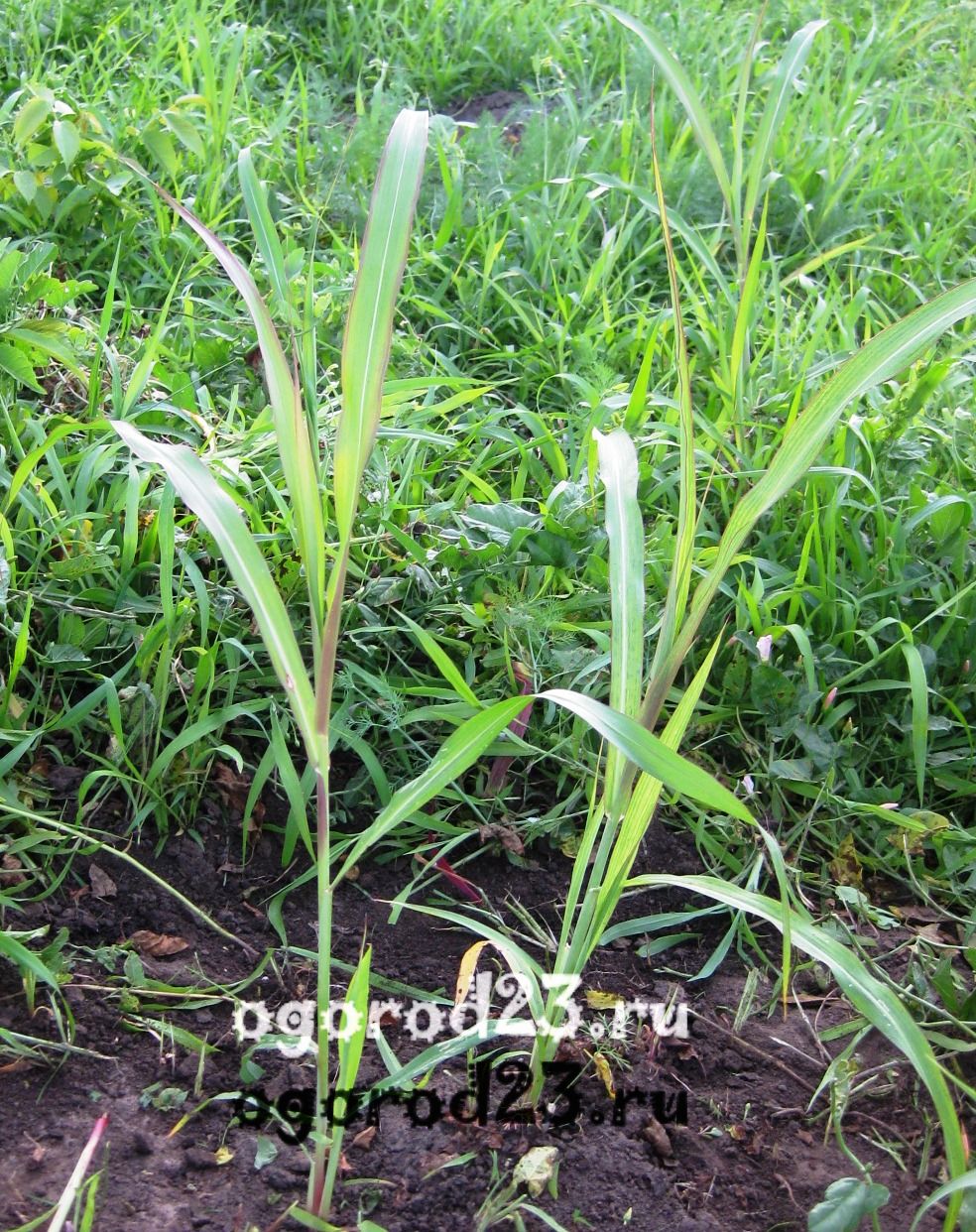 Svinora - spreads quickly across the field, thanks to powerful lateral roots
Svinora - spreads quickly across the field, thanks to powerful lateral roots 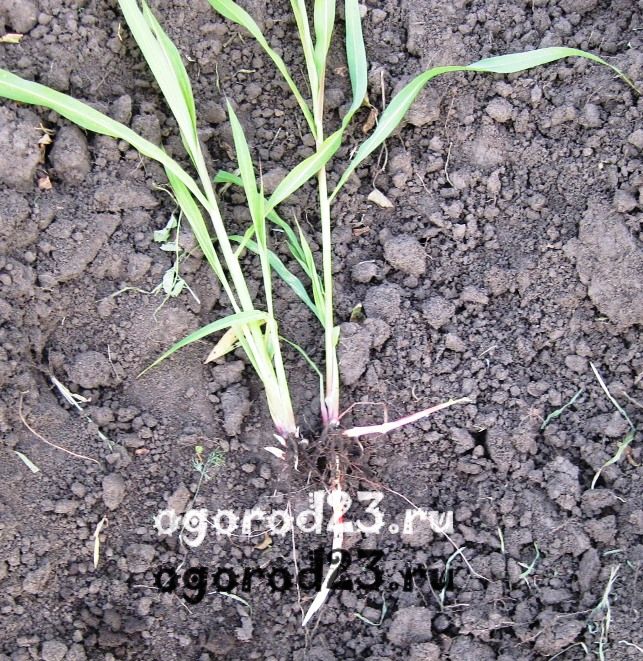 Pig with root system
Pig with root system  Svinoroy has already given side shoots - this is how he breeds
Svinoroy has already given side shoots - this is how he breeds Svinora is also very difficult to destroy. Propagated by pieces of rhizomes, which are formed when weeding with a hoe or when digging, plowing. Drought does not take it, since the roots can go deeper into the earth more than 1.5 m. That is, it is almost impossible to destroy it mechanically. For example, I left unplanted a part of my site, where the pig was especially rampant, I processed it with Tornado. Helped where the weed was treated.
But, nevertheless, everywhere I could not remove the pig from the first time. The task is complicated by the fact that he crawls out of the ground after the emergence of seedlings of garden plants. It is dangerous to treat with herbicides - you can inadvertently hurt garden shoots. It remains only to wait for the harvest ... And all summer I walk around the site after the rain, I pull it out with a pig, or rather, I try to pull it out, since the main part of the root still remains underground. I rip it out where it grows too close to, for example, a pumpkin or squash bush. And if I see a pig between garden plants, then I just cut off the spikelets that begin to form in order to somehow prevent its seed reproduction.
I am familiar with one gardener who destroyed a pig (he has 8 acres of land) - his plot has been free from this weed for several years. For many years in a row, after autumn plowing, he walked around his field with a trident hand cultivator, pulling out of the freshly plowed land the roots of the pig-grower cut by the plow.
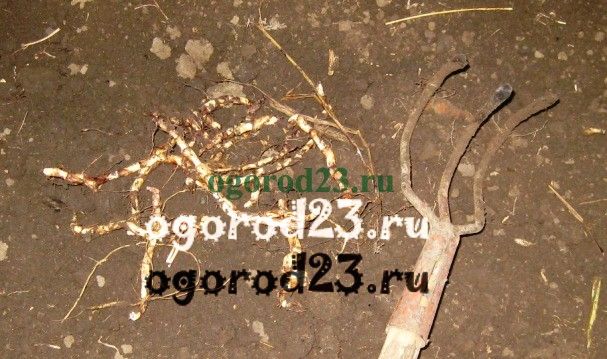 pig root
pig root Of course, it will not be possible to select all the roots at once - in this way only a small part of them can be collected - the main root still remains deep underground, but by doing this annually, we weaken the weeds - sooner or later we will defeat it. It is necessary to choose everything from the earth, even small parts of the pig root. The smallest piece, less than 1 cm long, will sprout in the spring. In the spring, again, you have to go through the plowed field - for sure, the roots that we accidentally walked around in the fall will be found. Mechanical weed control with pigs should be combined with treatment with drugs.
The third year has gone since the first treatment of weeds with chemicals in the fall. Recently I prefer to use Tornado. There are much fewer weeds where I plant potatoes, corn, sunflowers, pumpkins, zucchini. There is almost no wheatgrass. But there are still others ... After harvesting, it is still easier to deal with them.
But the areas planted with strawberries, raspberries, and other perennial crops are completely or partially freed from weeds, very laborious, almost daily work ... I still dream of planting strawberries on a black spunbond, which covers the entire earth, preventing grass from germinating. But so far I’m only dreaming ... Although there is a positive experience in weed control in this way.
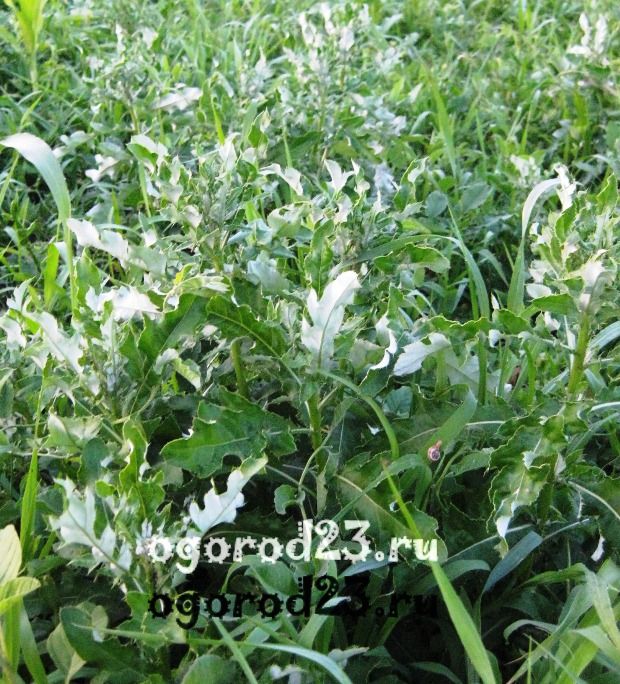 Thistle thickets
Thistle thickets  Here is such a sow thistle 1.5 meters high - freedom!
Here is such a sow thistle 1.5 meters high - freedom!  This is how thistle blooms
This is how thistle blooms 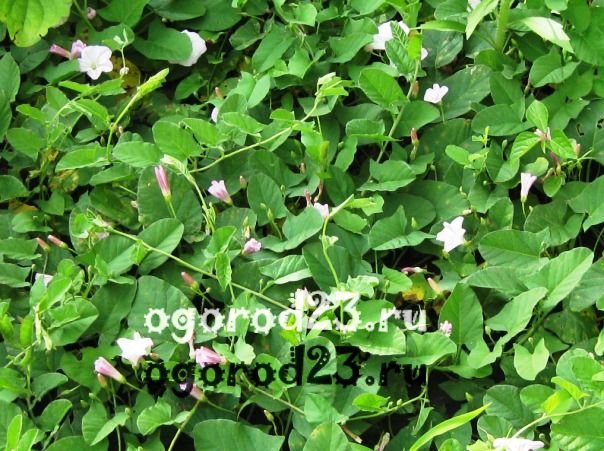 Birch (bindweed) braided everything - even the earth is not visible
Birch (bindweed) braided everything - even the earth is not visible 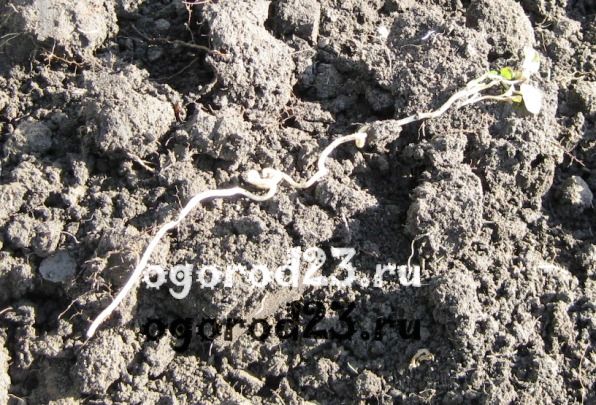 Birch in spring - the main part is underground
Birch in spring - the main part is underground I use herbicides only on large plots of land that I have for growing potatoes, corn, sunflowers, pumpkins. I try not to treat small areas that are located between fruit trees, shrubs, between areas planted with strawberries, raspberries.
Purslane garden, photo and how to get rid of
 Purslane garden - it's still very small
Purslane garden - it's still very small This year there were a lot of garden purslane. It has fleshy dense leaves, reddish thick stems, grows, as it were, with a rosette. Sometimes one weed with its shoots can cover a significant area of \u200b\u200bthe earth. It appeared from the ground after the potatoes had sprouted. It was impossible to spray with poisons. I had to spend the whole summer working as a chopper. This weed is also unpleasant in that after weeding it must be removed away, left, it can take root again if left on moist soil, for example, after rain. A chopper for purslane is not always dangerous - its basal neck is underground, if cut above it, new shoots will soon appear. It is best to pull it out of the soil with a root or cut the root with a chopper at a depth of at least 2 centimeters.
Weed wood lice - photo how to fight
Woodlice or chickweed is a weed that spreads especially quickly where carrots grow.
 Mokritsa can occupy a huge area
Mokritsa can occupy a huge area This uninvited "neighbor" thickens plantings, prevents the normal development of plants. How to deal with such a weed as wood lice?
The struggle will be successful with the help of kerosene. Fill the sprayer with a small amount of kerosene - 100 grams will be enough. Spray crops of carrots, while capturing the aisles where wood lice grow. This should only be done when the shoots of woodlice are in the phase of three leaves, only in dry sunny weather. After two or three days, the wood lice will wither, and then dry up. Don't worry, the carrots will keep growing. From my own experience, I can say that after such treatment, it grows even better.
Chistets forest - a weed
There is another weed in my garden that is very difficult to get rid of. This is a forest cleaner.
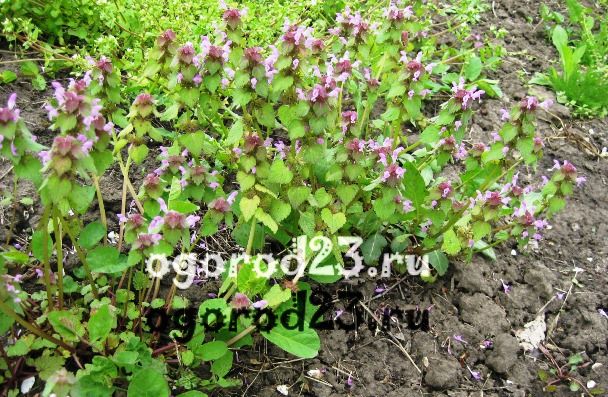 Chistets forest (deaf nettle)
Chistets forest (deaf nettle) It is also called deaf nettle, frog, snake grass. And as children we called it dog nettle or "dog" - the flowers are shaped like an open dog's mouth. This is a perennial. No digging, weeding does not help. April-May blooms in the Kuban. It reproduces from nodules, which are located at the ends of the roots, are deep underground. It also reproduces by seeds, but they have a thick shell, so it is difficult to germinate. The only plus of this weed is that if it is weeded in the spring, then this year it will no longer appear, it will rise only next spring.
Watch a video that offers a very effective way get rid of weeds forever.
If grass grows from cracks in a concrete path, or any other hard surface, prepare the following mixture: 2 cups vinegar (9%), 1/4 cup salt, a few drops of liquid dishwashing detergent. Place the mixture in a jar or bottle, screw on the lid, shake well. If the cracks are narrow, then draw the mixture with a syringe, bring it inside the crack along the entire length. And if the cracks are wide, then fill the crack with a mixture through the narrow neck of a bottle or the spout of an old teapot. An easy alternative to this method is to pour boiling salted water into the cracks. But it is desirable that water does not get into it and does not harm garden plants.
 Ambrosia is very harmful to vegetable gardens, people suffering from allergies
Ambrosia is very harmful to vegetable gardens, people suffering from allergies 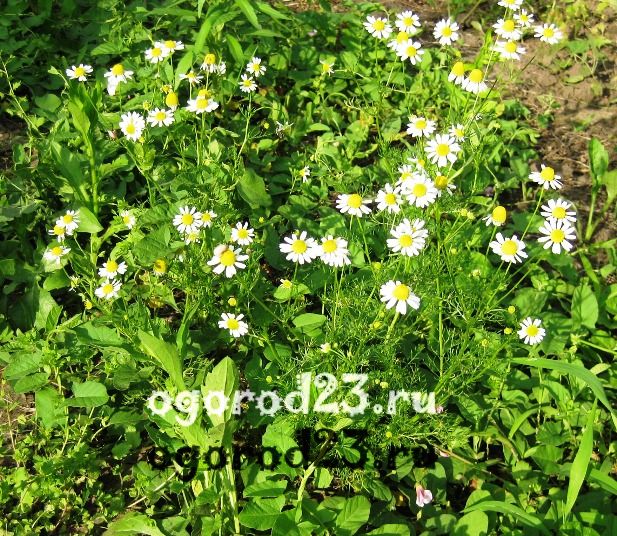 Chamomile pharmacy - beautiful, useful, but only outside the garden
Chamomile pharmacy - beautiful, useful, but only outside the garden I tried to describe here the main weeds, the names of which I know, which grow in my garden. But there are those whose names I don’t know ... I will try to gradually upload photos of weeds unknown to me, and from you, dear readers of my blog, I’m waiting for messages in the comments - suddenly someone knows, writes its name, distinctive features which will help you get rid of it faster.
By the way, you can take a picture of your weed, attach a picture to the comment. Perhaps, by joint efforts, we will “recognize her by sight” - it will become more difficult for weeds to live with us.
P.S. The article was written a long time ago. I really used Roundup for several years in a row. But now, I would not suggest it to you for weed control - there was information about the almost lethal effect of one of the components of Roundup - glyphosate. It has been claimed by the world's leading oncologists that the world's most widely used herbicide may cause cancer! Nowhere did I find information about the mechanism of the impact of Roundup on the human body. I can only assume that it is harmful to inhale small droplets when spraying. It is dangerous for the skin, mucous membranes. If you still decide to use Roundup, then be sure to use protective equipment - a respirator or bandage, glasses, gloves, trousers to protect your eyes, skin of hands, feet from getting the product. Roundup is actively promoted by Monsanto, but may appear under our trademarks"Rodeo", "Accord", other names may appear over time.

When the sowing of crops ends, difficult days come for summer residents - the time for weeding. Of course, for those who have small plots and grow greens for the soul, this does not cause any problems. But for the owners of 20-30 acres, things are different.
After all, you don’t want to spend the whole summer over the beds. Therefore, more and more summer residents are using recently special means which will surely make their lives easier.
Means intended for the destruction of weeds
There are two ways to deal with pests:
- mechanical;
- chemical.
The first method includes cutting or weeding the site. You should not be sure that after the pest plants disappear, the lawn will forever remain perfectly clean.
This procedure should be carried out regularly, especially in relation to such representatives of the flora as dandelion, wood lice, bindweed. They fill the most cultural plantings.
Lawn care rules:
- use a garden fork or other tool for the manual method of weed control, as this work is quite painstaking, requiring a lot of time and effort;
- be careful not to disturb the soil and remove the pest along with the root using a tool. Otherwise, the weed will easily grow back.
Mowing the lawn should be done regularly so that plants such as chamomile, nettle, dandelion, bindweed and other weeds cannot reproduce. Many believe that the most harmful representative is moss. To fight it, you need to aerate the soil, comb it and pierce it with a rake.
The chemical method consists in the use of herbicides. These are the means to destroy a protracted problem completely. Preparations should be applied only when the lawn gets stronger. And this is not earlier than a year after landing. Not all types of lawn grass positively tolerate the effects of these drugs.
After processing such weeds, special care is required. For example, if drugs with a strong effect were used, you can cut the grass only after 3 days. It is recommended to use chemistry in dry calm weather. Read the instructions carefully before use.
Weed control with folk remedies
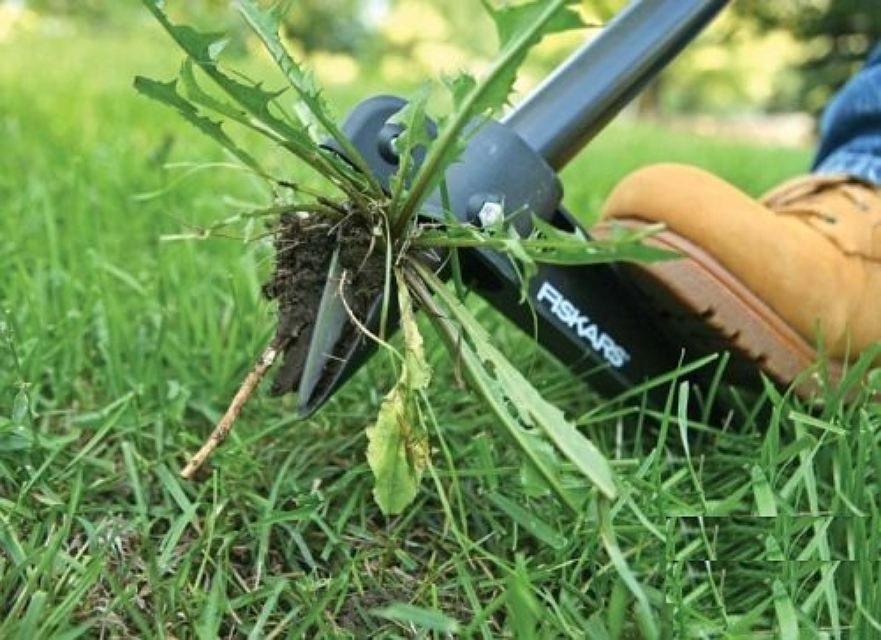
- Use of alcohol. In order for the culture in the country to grow well and not to overgrow with grass, it must be disinfected. To do this, alcohol is diluted with water in a ratio of 1:10, and the land around the plantings is cultivated with this solution. There is an assumption that harmful plants will not grow on such land, at least in the coming season;
- Application of herbicidal soap. This is very effective method. To make it with your own hands, you need to mix salt, vinegar and grated laundry soap in equal proportions. Spray the mixture evenly on the weeds;
- Using vinegar and salt as a weed killer. Of course, purchased herbicides are effective drugs. However, they are expensive, and most gardeners use chemistry in the garden once again Do not wish. Therefore, many site owners replace purchased drugs with folk ones. Acetic acid is used as a simple and safe method.
For spraying the beds, a 5% solution is used. To process the entire yard, a more effective folk remedy is used - vinegar and salt. It is prepared in the following way. Pour 4 liters of 9% vinegar into a bucket, pour half a glass of salt, add liquid soap and mix everything thoroughly. It should be used in the same way as chemicals: spray very carefully so that drops do not fall on cultivated plants. best time early morning is considered for processing.
Lawn weed control
If pests have not been pre-treated in the first season, they will begin to fill the free places very actively. And so the fight against them will continue for quite a long time.
To get rid of annual plants, you need to mow them along with the grass before flowering. Then they will not have time to form seeds and spread around the site. The first segments of the root of annuals will not disappear, but the plant will weaken. And the subsequent bevel will finally get rid of pests. Lawns should be mowed as they grow, but at least once every 2 weeks.
In addition to annuals, there are creeping weeds that do not fall under the cutting height and grow further. This is wood lice, bindweed and others. To get rid of them, you need to comb the lawn with a rake, then it will be possible to suppress the roots of creeping plants.
The most dangerous enemy of the lawn is a perennial with powerful roots. These are dandelion, plantain, sow thistle, chamomile. You can’t take them with a mower, because in the case of a haircut on the roots, dormant buds wake up almost instantly, from which even more unwanted “guests” sprout. This type pests in the first year of the life of the lawn is removed only by hand, and it is better to try to pull out the entire root. The slightest residue forms a new plant.
If you carry out the entire procedure with your own hands, then a convenient time for this is after the rains, so that the roots easily slip out of the wet ground.
How to permanently get rid of weeds with folk remedies

There are ways by which you can deal with weeds very effectively.
Salt is one of the most accessible products. It is enough to sprinkle around the garden bed, stepping back a little from it, but not less than 30 cm, a small amount of salt and soon the pests will die. However, after the next watering, brine will penetrate into the soil layer and will interfere with the development of the growth of new plants.
Soda is a natural home alkali, which is used quite actively by summer residents and helps in weed control.
To do this, it is enough to pour a small weed with a soda solution, and the effect will not take long. The distance to cultivated plants should not be less than 30 cm.
Vinegar literally burns plants alive, so it's best to use a spray bottle to spread the acid. Be very careful, vinegar also negatively affects cultivated plants.
Also great help paper or sawdust. In autumn, before the onset of the first frost, cover the edges of the beds and garden paths with sawdust. A year later, they can be transferred to the garden, dug up with the ground, and pour new "barriers" around the edges.
Weed control products used in the garden
Folk methods are undoubtedly good, but they do not always work effectively. And then chemicals come to the rescue. Processing is carried out with herbicides - one of the most effective ways weed control. Means of the brand "Tornado" or "HuraganForte" and other substances have been helping summer residents for more than a year. They are applied to the surface of plants, which later die, absorbing harmful substances.
It is important that these products are safe for the soil cover, and after chemical treatment, garden crops can be safely planted in this place. Each drug has its own duration of action, which depends on the composition. Important role plays the degree of resistance of harmful grasses to herbicides. Usually, it takes at least 14 days to completely free the soil from pests, and it is necessary to deal with the problem with such means with particular care. The poisons contained in the preparations destroy weeds and any plants, so chemicals are sprayed far from the beds with plantings.
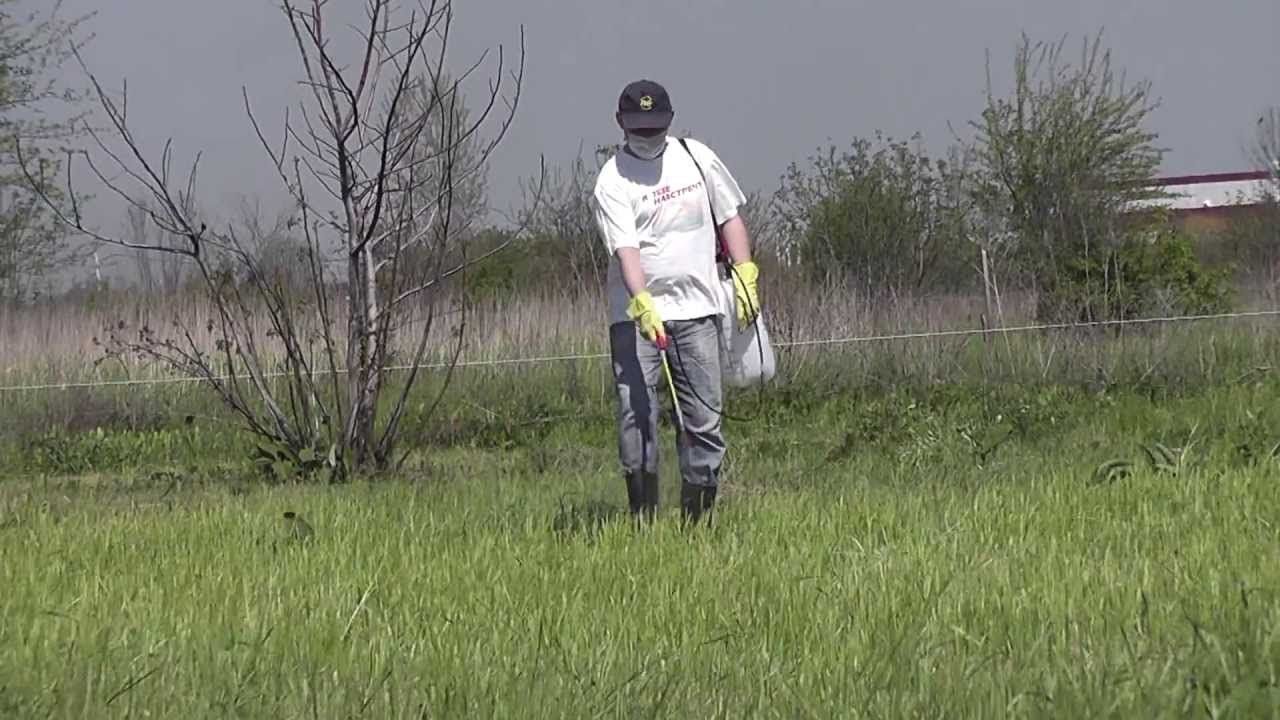
"UraganForte" is a universal preparation applied to all types of weeds. It penetrates the plants through the stems and leaves, and after 4 weeks it dies. The tool can be used throughout the season. Within a week after applying "Tornado", the plant begins to turn yellow and wither, and after 3 weeks it dies. It is a harmless preparation for the soil, and therefore, after several days of treatment, you can safely plant a cultural crop.
Also effective tool from unnecessary grass is "Roundup". It permanently eradicates weeds within a couple of weeks.
It is necessary to use herbicides according to the instructions, then they will not harm either you or your crops, only weeds.
As it turned out, weed control in the garden is not difficult. The main thing is to choose the right remedy to completely destroy them.
The most traditional way, by which mankind has long been fighting weeds, is a chopper and all kinds of flat cutters. But this method, although effective (if you appear in the garden with a tool 2-3 times a week), is very energy-intensive. Not everyone knows that weed control can be carried out with folk improvised means without the use of chemistry. Let's find out which ones!
If you do not know how to remove weeds on the site folk remedies, look in your kitchen cabinet. The strong acid contained in a bottle of the usual 9% is a terrible enemy for weeds. After filling it in the sprayer, direct the jet at the weeds and see the long-awaited reaction. It is important that there are no cultivated plants nearby, because they are also affected.
Dangerous mix
Based on vinegar, salt and laundry soap, taken in equal proportions, you can make a truly infernal mixture. It burns all living things, and therefore it is better to process the site in this way before planting it with vegetables or flowers.
Grain waste
Paradoxically, but among the folk remedies that can save from weeds in the garden is feed grain. This is a battle of wheat, barley, but corn is best. How does this system work? Very simply - due to the entry into the soil of gluten contained in crushed grain, it affects the weed, preventing it from germinating. But you can sprinkle the plot with it only when the vegetable crops have already gained strength and built up a powerful root system, otherwise this effect will affect their growth.
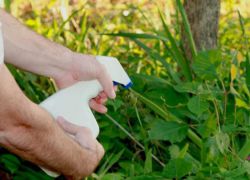
Alcohol
If you don’t know how else you can get rid of weeds in the garden with harmless folk remedies, try diluting alcohol in a ratio of 1:10 and watering the ground with it in early spring. Experienced gardeners guarantee that this season it will be possible not to remember the hated grass. In addition to auxiliary substances that can neutralize weeds, soil mulching with various synthetic covering materials, as well as natural ones - tree bark, sawdust, cardboard or paper, works well.







